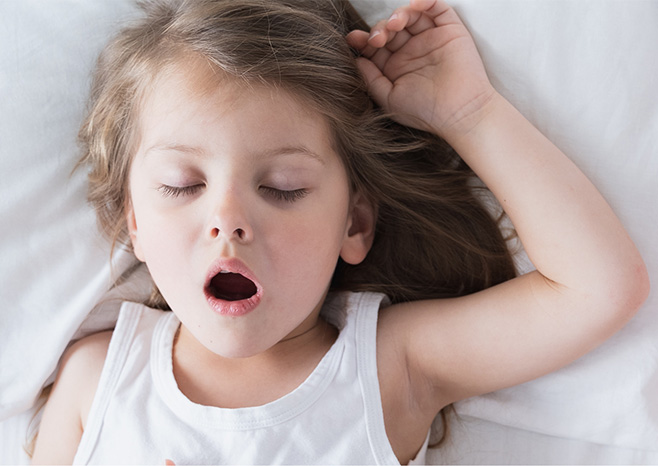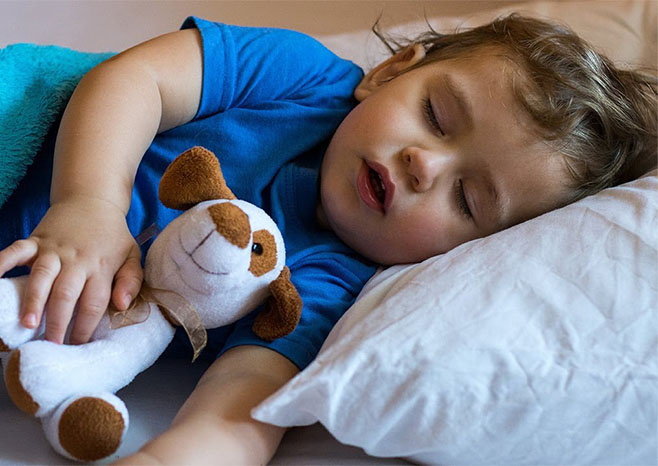Symptoms Of Pediatric Obstructive Sleep Apnea

Accurately identifying obstructive sleep apnea (OSA) in pediatric populations is critical from a clinical perspective as it is the most severe sleep breathing disorder1.
For healthcare providers, understanding the prevalence of these issues and their demographic variations can encourage more frequent, comprehensive, and specific screening efforts, guiding decisions about the necessity for further diagnostic evaluations and treatment.
Symptoms of OSA can be grouped into three categories: general indicators, physical signs, and behavioral manifestations. We will list specific examples for each category in this article to help identify the presence of OSA in pediatric patients.
General Indicators of Pediatric OSA
In the pediatric population, snoring is observed in 3 to 12 percent of children, while obstructive sleep apnea syndrome affects 1 to 3 percent of children2,3.
Common symptoms of pediatric OSA include the following,
- Restless sleep
- Daytime sleepiness
- Heavy breathing
- Bedwetting
- Frequent snoring often with pauses between breaths
- Difficulty waking up in the morning
Most children experience mild symptoms, and many outgrow the condition.
However, OSA has become a public health concern due to the increasing rates of obesity and hyperactivity in children between the ages of 2 to 144.
A study shows that a significant percentage of children displaying hyperactivity or inattentiveness had an underlying sleep-disordered breathing condition3.
Physical Signs of Pediatric OSA
Children with obstructive sleep apnea syndrome typically display the following physical symptoms, although this is not an exhaustive list5.
Nose:
- Swollen nasal mucosa
- Deviated septum
Mouth:
- Hypertrophied tonsils
- High arched palate
- Elongated soft palate
- Macroglossia
- Glossoptosis
Face:
- Midfacial hypoplasia
- Micrognathia
- Long face syndrome
As part of the physical examination, it is essential to evaluate the child’s growth pattern. Children diagnosed with OSA symptoms often show signs of delayed growth and impaired weight gain1. Conversely, children who are obese have a 4.5-fold increased risk of developing OSA6.
Behavioral Manifestations of OSA
During the day, children with OSA can experience the following symptoms, although this is not an exhaustive list5:
- Poor performance in school
- Trouble paying attention
- Hyperactivity
- Learning and behavioral problems
Excessive daytime sleepiness is thought to be linked to sleep fragmentation and can impact sustained attention. Multiple studies support the connection between sleep-disordered breathing and both hyperactive behavior and inattentiveness3,7,8.
Despite identifying pediatric OSA symptoms, using polysomnography is still the gold standard for confirming and diagnosing the existence and extent of sleep-disordered breathing in children in all age groups9.
If your pediatric patients have enlarged tonsils and are experiencing other symptoms of OSA, consider exploring COBLATION◊ Technology for tonsillectomy.
Disclaimer: Smith+Nephew does not provide medical advice. The information presented is not, and is not intended to serve as, medical advice. It is the responsibility of healthcare professionals to determine and utilize the appropriate products and techniques according to their own clinical judgment for each of their patients. The information presented may not be appropriate for all jurisdictions.
1. Savini, S, Ciorba, A et al. Assessment of obstructive sleep apnoea (OSA) in children: an update. Acta Otorhinolaryngol Ital. 2019;39(5):289–297.
2. Chan, J, Edman, JC, et al. Obstructive Sleep Apnea in Children. Am Fam Physician. 2004;69(5)1147–1155.
3. Chervin RD, Archbold KH, Dillon JE, Panahi P, Pituch KJ, Dahl RE, et al. Inattention, hyperactivity, and symptoms of sleep-disordered breathing. Pediatrics. 2002;109:449–56
4. Sanyaolu A, Okorie C, Qi X, Locke J, Rehman S. Childhood and Adolescent Obesity in the United States: A Public Health Concern. Glob Pediatr Health. 2019;6:2333794X19891305.
5. Katz, ES, Ambrosio, CM. Pediatric Obstructive Sleep Apnea Syndrome. Clinics in Chest Medicine. 2010:31:221–34.
6. Redline S, Tishler PV, Schluchter M, Aylor J, Clark K, Graham G. Risk factors for sleep-disordered breathing in children: associations with obesity, race, and respiratory problems. Am J Respir Crit Care Med. 1999;159(5 Pt 1):1527-32
7. Csábi E, Gaál V, Hallgató E, Schulcz RA, Katona G, Benedek P. Increased behavioral problems in children with sleep-disordered breathing. Ital J Pediatr. 2022;48(1):173
8. Gottlieb DJ, Vezina RM, Chase C, Lesko SM, Heeren TC, Weese-Mayer DE et al. Symptoms of sleep-disordered breathing in 5-year-old children are associated with sleepiness and problem behaviors. Pediatrics. 2003;112(4):870-7
9. Rundo JV, Downey R 3rd. Polysomnography. Handb Clin Neurol. 2019;160:381-392.


